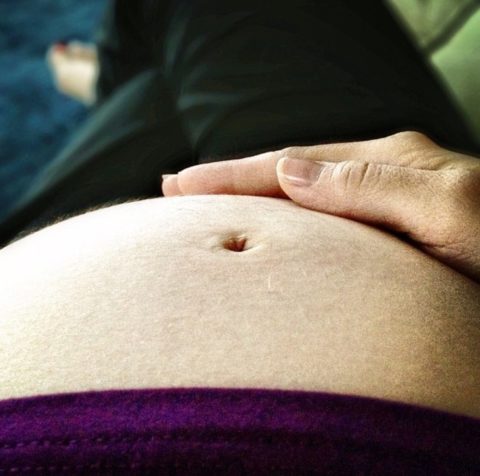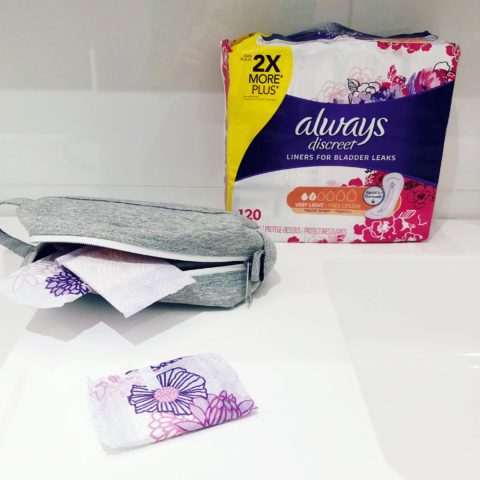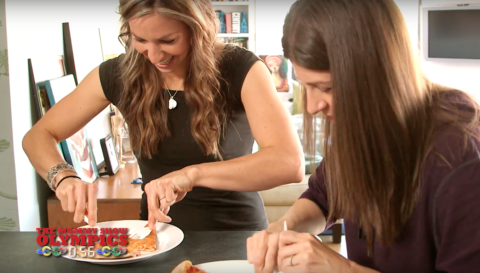
A few weeks ago, I asked you guys to share some of the unexpected ways pregnancy changed your body for a sponsored post I was working on with Always Discreet. Your answers were so honest and amazing that my 24-year-old editorial assistant Allie decided she is no longer having children. It was also one of the most popular posts on my blog all year, so thank you guys for that!!!
About a quarter of your comments mentioned “peeing in your pants,” whether it be from laughing, jumping, walking in the cold, etc. which was reassuring, because people usually associate incontinence with senior citizens, so it’s helpful to be reminded that one in three moms struggle with this issue too.
One of the comments was from fellow RAP (Remarkably Average Parent) Amanda Hromadka Biehl who is a Pelvic Rehab Physical Therapist. She said that a lot of the problems mentioned in the post could be fixed or improved upon, so I asked Always Discreet if we could let Amanda do a follow-up post to answer any questions you guys might have about bladder health.
In addition to incontinence, she also specializes in constipation, prolapse, pain with intercourse, diastasis recti, pre/post partum issues, and general orthopedics. All things that are pretty common after pregnancy, but not usually openly discussed. And looking this stuff up online can be tough, because you can go down rabbit holes of wrong information, PLUS, then Google and Facebook have you marked for vagina related advertising for life. Not exactly what you want popping up when you check Facebook with Grandma over Christmas.
Anyhoo… did you know that November is Bladder Health Awareness Month??? Well, now you do! Start celebrating! What? You don’t have any parties lined up? Well, that’s okay, because this post with Amanda answering all of your burning bladder related questions (that should not be read literally) will suffice. Read it with a glass of bubbly in hand.
Before we get started, I want to give you a disclaimer directly from Amanda: “Obviously, this information doesn’t take the place of a thorough medical evaluation by your MD, PT, etc… it’s just helpful advice, and I always recommend following up with your own medical team!”
I went for pelvic floor physical therapy many years ago and it was hugely helpful for me. I’m hoping many people will benefit from this post. When I saw my primary care I was whispering my complaints with tears in my eyes. I had never even mentioned it to anyone, even my mom, before my doctor, because I was so embarrassed. She sent me to a Urologist-gynecologist where I learned my issue was really common. I never knew that! Why do you think it is such a hugely under-discussed topic?
I think many women are too embarrassed to discuss it. Most women don’t even bring it up in their annual appointments with their Gynecologist because unfortunately they’ve only heard from their friends and family that “it’s just what happens when you have a baby or you get older!” So it doesn’t really even seem like a big deal – until it is! They bring it up when they notice they’re having to make changes or stop doing things, but I want EVERYBODY to know that preventative care is the golden ticket! Find out BEFORE you’re having issues how you can protect yourself! It’s such an important conversation and I’m so thankful for Ilana giving me the platform to speak freely about it.
How common are pelvic floor issues in women?
Urinary incontinence is estimated to affect over 25 million Americans and 1 in every 4 women over the age of 18 report accidental leakage, so it’s EXTREMELY common, yet hardly ever discussed. Over time, women have been told that “it just happens after a baby,” “it’s because you’re getting older,” “it’s only a tiny bit when I laugh or sneeze too hard,” and “it’s really not that big of a deal.” But, it is a big deal if you have to make changes to how you live your life! I have patients who say that they can’t run after their kids, they can’t play on a trampoline, exercise, belly laugh, or have sex without fear of leaking. One of the most memorable quotes a patient told me was, “I didn’t realize how many times I was saying no to things, until I didn’t have to anymore.” Just because these issues are common, does NOT mean you have to continue to live with them. There is help!
What is a typical appointment like for pelvic floor therapy?
Your initial evaluation should start with your Physical Therapist (PT) listening to you. We want to know about symptoms, medical history, and any other pertinent information that might help you get better. You’ll be asked about your specific goals and your most troubling symptoms. There is no such thing as TMI, believe me— we’ve heard it all! Be as honest as you can because everything can be considered a piece to the puzzle!
After that, a thorough physical examination of your functional mobility, strength, and flexibility will occur. This is VERY important because your pelvic floor is connected to your abdominals, back, hips, diaphragm, etc. You can’t just look at the pelvic floor, which is the problem when Dr. Google tells you that kegels are the answer! Ha! Then, depending on your symptoms and comfort level, we will perform an external and/or internal pelvic floor examination. This exam is completely different from an internal exam you may have had performed by either a urologist or gynecologist. Exams are as pain free as possible, as we do not believe we need to increase your pain to decrease your pain.
Before the appointment is over, an individualized treatment plan should be created with your therapist to help you meet your goals. There is no “cookie cutter” program, since no two bodies are exactly the same. Depending on my patient’s goals, they will then come in once a week, once every other week, or sometimes even just once a month.
Is physical therapy recommended before or more often than surgery? A good friend had a bladder sling and said it was life changing. Is one considered before the other or is it up to the individual?
I’m always going to be pro-PT first, unless the surgery is absolutely medically necessary of course! If the bladder issues or prolapse issues are a result of muscle weakness, poor breathing, poor body mechanics, poor bladder or bowel habits, and those issues aren’t addressed before surgery, then surgery might not get you the desired results, or maybe it will, but the results won’t last as long!
The goal of PFPT is to decrease the need for surgery with a conservative treatment plan, but after all that hard work, surgery might still be is required. The good news? You’ll be at a much better place for healing and increase the longevity of your surgical results by starting with “pre-hab” first!
I pee every time I cough, sneeze, laugh or even breath too hard! It’s so embarrassing. I’ve had a full abdominal hysterectomy. I wear bladder pads and I change them constantly. I’ve done at least a zillion kegels with zero improvement. Both my children were C-section. So, my question is— how did this happen and what can I do to fix it?
A lot of women are surprised that they can still experience incontinence and PF dysfunction without having a vaginal birth! Pregnancy is hard. There’s a lot of pressure on the pelvic floor, the way you breathe changes, the abdominal muscles are challenged, etc… so, there’s a lot going on! It’s not uncommon at all for my patients to have had C-section births. In regards to the “zillion kegels,” probably 95% of the women I see aren’t doing kegels correctly. If you aren’t doing an exercise correctly, then it’s probably not going to help. It’s also important to note that incontinence is not solely a weakness issue. Sometimes the pelvic floor muscles can’t/won’t go into full relaxation, and you need full muscle action for that muscle to work correctly. Keep in mind, a tight muscle is a weak muscle too. This means that even correctly performed kegels can sometimes do more harm than good!
I was horribly constipated after both my kid’s births. The first was a C-section (expected some constipation) but the second was vaginal (did not expect the constipation). Why on earth was I not more pre-warned about this leaving the hospital? They should have sent stool softeners home with me!!!
Constipation is VERY common with pregnancy and after delivery for so many reasons— prenatal, iron, epidurals, pain medicine, pelvic floor muscle dysfunction, etc. can all contribute. The easiest answer is… water, water, water, and more water! The other solution is learning how to poop correctly. Nobody ever tells you that there is a correct way to poop when you’re a kid, but there is! Lean forward in a “reading posture,” visualize your pelvic floor relaxing as if a flower is blooming (a contraction would be like a rosebud), and use your abdominal muscles as helper muscles, by letting your belly expand and then contracting your abdominals. It’s also important to BREATHE while pooping. Do not hold your breath and push down!
Are there easy ways to solve Diastisis Recti on your own at home? I’ve seen online programs you can buy, but are they really worth it?
For those who don’t know, Diastasis Recti means your belly sticks out because the space between your left and right abdominal muscles has widened. You might call it a “pooch.” The complicated thing about it is that it isn’t JUST the separation of the muscles that’s the issue. The skin on your tummy can become restricted (c-section scars, etc) and there’s something called fascia under the skin that’s connected to your abdominal muscles that can become restricted as well. Your abdominal muscles wrap the trunk (think weakness, tightness, etc), and then there’s a visceral layer under the muscles/on top of the organs, which can also become restricted, as well as limited diaphragm movement and rib mobility, and well— you get the point! You can’t simply strengthen a weak muscle to make it all better. You have to figure out why it was weak in the first place and what we can do about it now to make it better and stronger, as well as how to prevent issues in the future. So my response is – it’s always best to get an evaluation by a pelvic floor PT to get a real understanding of what’s going on.
I am NOT the same after birth. At one point I really thought I was having prolapse because my opening down there seems to be exposing too much. This may be TMI but I can feel it when I wipe and after sex it bulges a little. It has gotten better over the past 2.5 years, but at one point, I made an appointment with my primary care doctor and she said I could possibly use reconstruction or even more stitching. I never followed up with my OBGYN because I feared it wouldn’t be covered by insurance. How common is it to get restitched? Are pelvic floor exercises something that can help my situation?
Prolapse is a scary word to some people, but it is also very common. It refers to the descending or drooping of any of the pelvic floor organs, including your bladder, uterus, vagina, small bowel or rectum. Women say that they can feel “heaviness,” “pressure,” or sometimes even that it “feels like a tennis ball inside my vagina.” The pelvic floor is a hammock. It holds all of those important organs of yours up where they need to be. If that hammock gets a little weak or is stressed with heavy intra-abdominal pressure (think holding your breath to poop, lifting heavy weights without breathing, impact exercises, etc.) then those muscles sag down a little and the organs come with it.
Please don’t google “prolapse” because it will show you the most extreme versions! Prolapse is typically recorded in 4 stages (Stage 0 being no prolapse, up to Stage 4 with the organ outside of your body all of the time.) The good news is that women with Stages 1-3 do incredibly well with PFPT! So much of what your pelvic floor needs to function correctly requires bladder retraining, bowel retraining, breathing instruction, body mechanics training, etc… it’s not just a weakness issue. If surgery is your option, then it’s important to work on those other things too to make sure your healing time is decreased.
I just had my fourth baby two weeks ago. Had my first almost exactly five years ago. Three days post partum, I went to the bathroom because I felt like I needed to poop. Afterwards, it felt like something was popping out of my vagina. My first thought was uterine prolapse, but my doctor basically told me this was normal for having *just* had a baby. She said if I do my kegels regularly, it should tighten back up. Is this actually normal for my situation? Will it be fixed just by doing kegels? Or should I try to get an appointment with a specialist, such as yourself?
It does sound like prolapse, but keep in mind that gravity could be an issue with how your OB/GYN is seeing things. Typically they assess you while you are lying down and gravity isn’t much of an issue. It’s not pushing down on you and you’re not lifting anything either (like your baby), but when you stand that changes! We don’t spend a lot of our day lying down, so when you stand for a long time, especially if you are active or lifting things, and yes, pooping, it puts more pressure on the pelvic floor and can increase prolapse symptoms.
The good news is that you’re still in the post partum healing period, and hopefully soon, you’ll start to notice a decrease in symptoms. However, it’s never too early to start working on pelvic floor exercises, making sure you’re exhaling when you lift, and resting when you start to feel heavy pressure. Listen to your body as much as you can during this healing time, and always get a second opinion if you don’t feel comfortable with the answer you’ve been given. A PFPT would be a great start to help you get back on track!
Can you recommend therapists in NYC?
This is a great resource for therapists all across the US: https://pelvicrehab.com/
I urge everyone, whether you are currently experiencing problems or not, to seek out pelvic health information that could prevent any issues from occurring later on down the line. Treatment isn’t just about strengthening— it’s about breathing, body mechanics, functional movement, bladder/bowel health, you name it. It’s all connected and learning how use your pelvic floor correctly can benefit everyone.
All of that being said, even while seeking treatment – sometimes extra help is needed too! There should NEVER be shame in using a pad, panty liner, or whatever form of assistance you need to help you get through your day. My goal as a Physical Therapist is to empower my patients to get back to do doing what they want to do, and sometimes that means using modifications/compensations that can help get you over a few hurdles. There are great products out there now that help give you the confidence and peace of mind you need to continue working on your boundaries, exercises, and techniques!
———-
Thank you Amanda for answering everyone’s questions! As Amanda said, these issues are very common and there should be no shame in talking to your doctor about your issues or using an incontinence product like Always Discreet. And just so you know, incontinence pads are different from menstrual pads because they are designed specifically to hold pee and disguise the odor. They are also way thinner than you think! You can purchase Always Discreet here.

Thank you Always Discreet for facilitating this very important discussion and sponsoring this post. Talking about these issues is the first step to eliminating the shame!
You read more from Amanda by following Reform PT on Facebook, Instagram or her website.

























Thanks for this post! I just wanted to say that if anyone is on the fence about PT, DO IT!!! It is so helpful and can make a huge difference in your life. And not just for Pelvic floor, many body aches and pains are caused by weak muscles, poor alignment or both. I had this stabbing pain similar to sciatica in my butt. It was so painful to sit, run and more. Turns out the cause was pelvic instability which caused other muscles to over work and become tight and painful. With some super simple core, glute and plevic floor exercises, i’m completely pain free! PTs are amazing!
I urge everyone, whether you are currently experiencing problems or not, to seek out pelvic health information that could prevent any issues from occurring later on down the line. Treatment isn’t just about strengthening— it’s about breathing, body mechanics, functional movement, bladder/bowel health, you name it. It’s all connected and learning how use your pelvic floor correctly can benefit everyone.